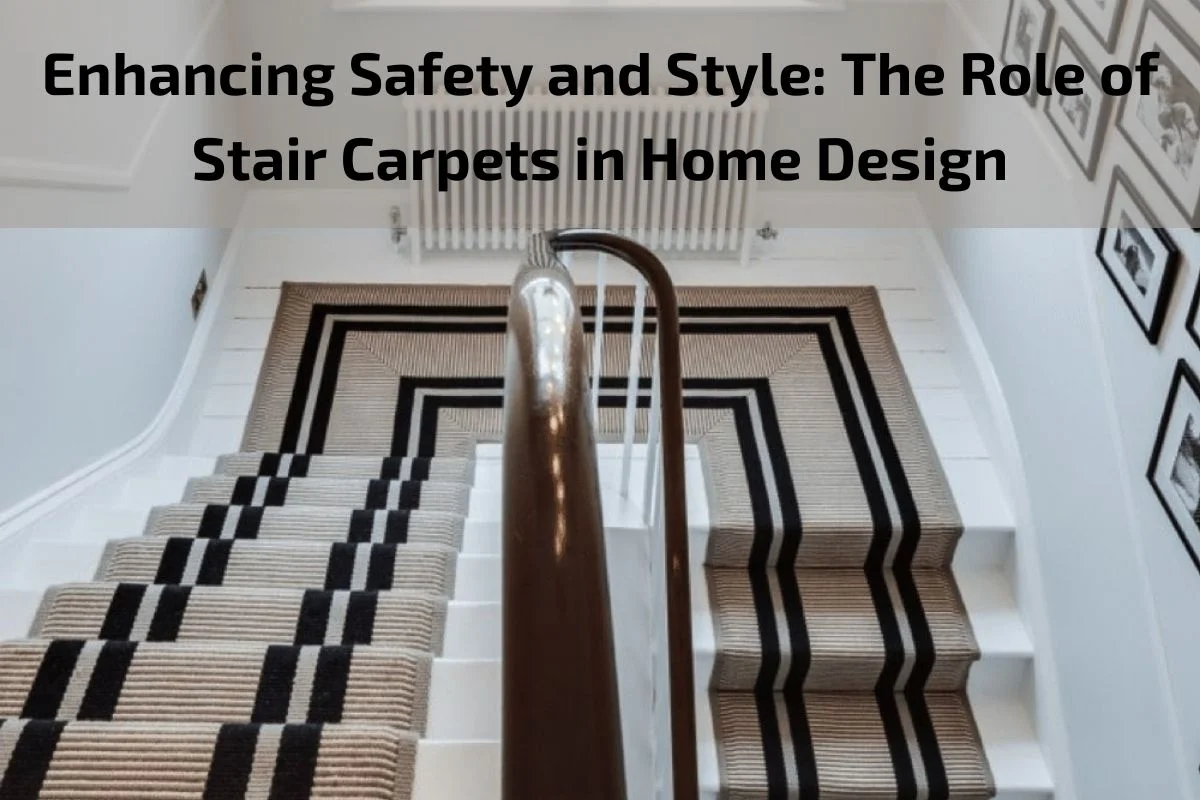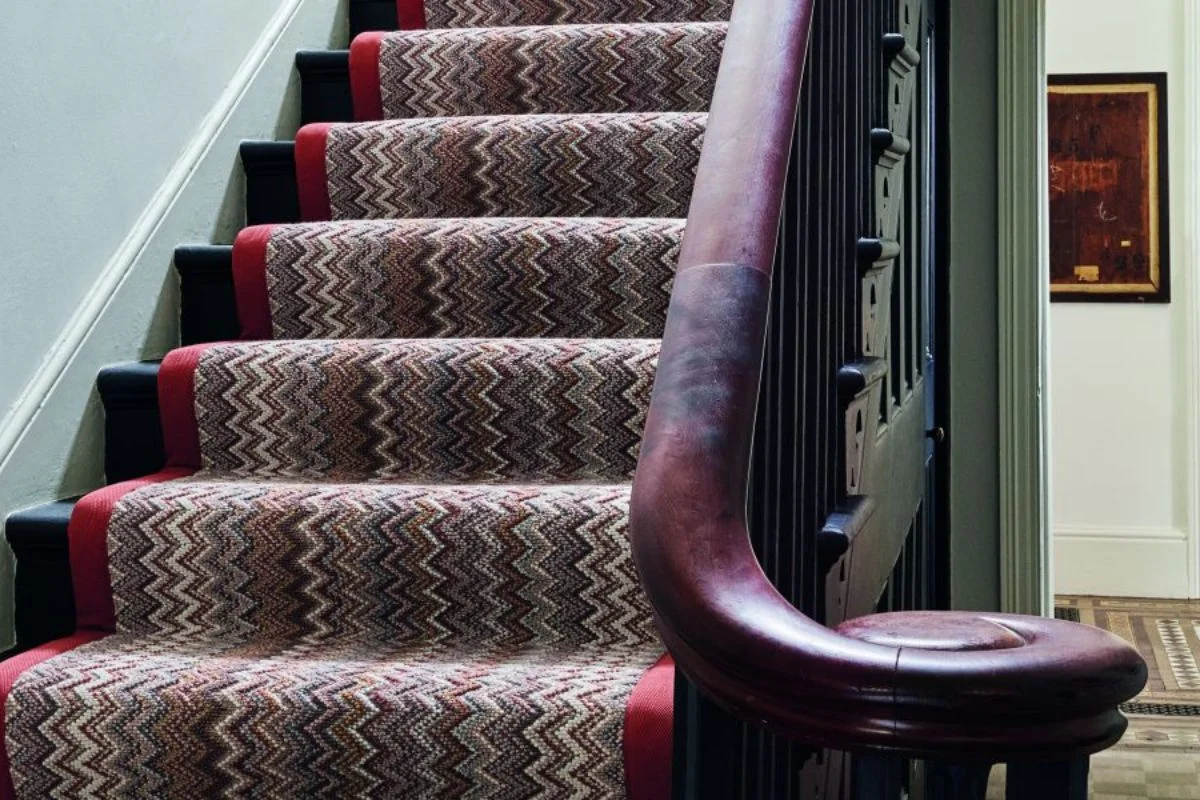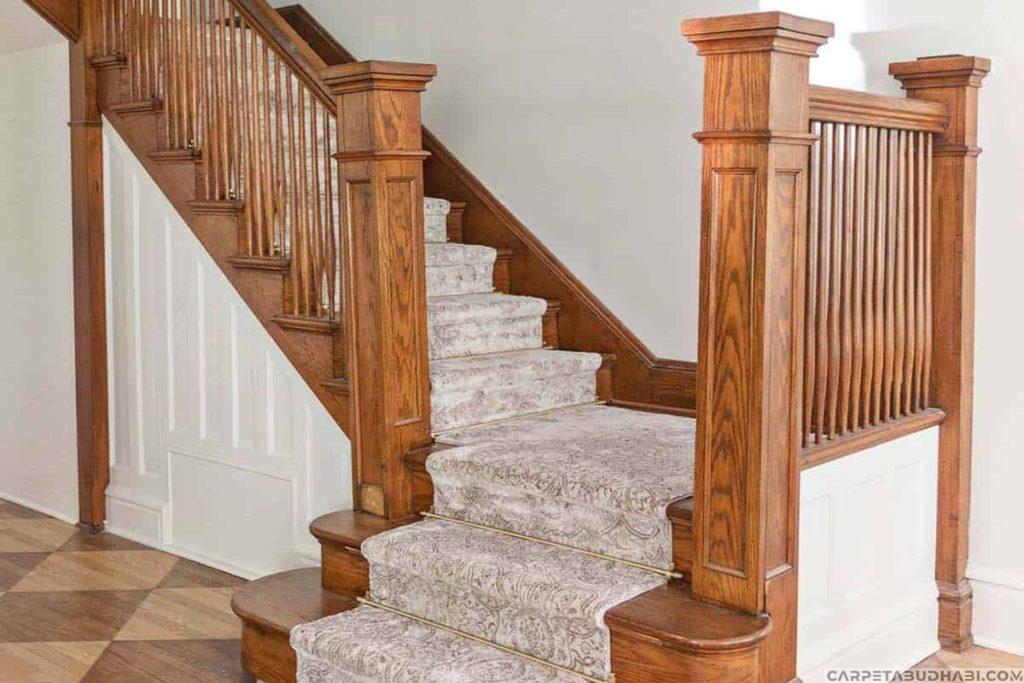
Stair carpets serve as both functional and decorative elements in home design, seamlessly blending safety with style to enhance the overall ambiance of living spaces. Beyond their practical purpose of providing traction and cushioning on staircases, stair carpets play a pivotal role in elevating the aesthetics of interior environments.
In the realm of home design, safety is paramount, especially in areas prone to slips and falls such as staircases. Stair carpets offer an effective solution by providing added grip and stability underfoot, reducing the risk of accidents and injuries. This safety feature is particularly beneficial for households with children, seniors, or pets, offering peace of mind to homeowners and occupants alike.
However, the significance of stair carpets extends far beyond their utilitarian function. They also serve as design elements that contribute to the overall visual appeal and personality of a home. From classic elegance to contemporary flair, stair carpets come in a myriad of styles, colors, and patterns, allowing homeowners to express their unique tastes and preferences.
Importance of Stair Carpets in Home Design
Stair carpets play a pivotal role in home design, offering both practical functionality and aesthetic appeal. Here’s why they are considered indispensable elements in interior decor:
Safety Enhancement: One of the primary reasons for installing stair carpets is to enhance safety within the home. Stairs, particularly in multi-level residences, can pose a risk of slips and falls, especially when they’re made of hard materials like wood or tile. Stair carpets provide traction and grip, reducing the likelihood of accidents and providing a secure footing for household members and guests, particularly children and the elderly.
Sound Absorption: Stairs can often amplify noise within a home, especially in households with high foot traffic. Stair carpets act as sound absorbers, dampening noise levels and minimizing echoes that can reverberate throughout the house. This contributes to a quieter and more peaceful living environment, enhancing overall comfort and tranquility.
Comfort Underfoot: Walking up and down stairs can be taxing on the feet, particularly if the stairs are made of hard materials. Stair carpets offer a cushioned surface that provides comfort and support underfoot, making the stair-climbing experience more enjoyable and less fatiguing, especially for individuals with foot or joint pain.
Aesthetic Enhancement: Beyond their functional benefits, stair carpets also contribute to the aesthetic appeal of a home’s interior design. They add warmth, texture, and visual interest to staircases, transforming them from utilitarian structures into stylish focal points. Stair carpets come in a variety of colors, patterns, and textures, allowing homeowners to personalize their staircases and coordinate them with the overall decor scheme of their home.
Versatility in Design: Stair carpets offer versatility in design, allowing homeowners to express their personal style and creativity. Whether they prefer traditional elegance, modern minimalism, or eclectic patterns, there’s a stair carpet option to suit every taste and preference. Stair carpets can be used to make a bold design statement or to seamlessly integrate with existing decor elements, adding depth and character to the overall design scheme.

The Practical Benefits of Stair Carpets
Stair carpets offer a multitude of practical benefits that contribute to the overall functionality and comfort of a home. Here are some key advantages:
Enhanced Safety: Stairs can be hazardous, especially when slippery or when visibility is low. Stair carpets provide added traction and grip, reducing the risk of slips and falls, particularly in households with children, seniors, or pets. The textured surface of the carpet helps to prevent accidents and provides a secure footing for ascending and descending stairs.
Sound Insulation: Staircases can act as conduits for noise transmission, particularly in homes with hardwood or tile stairs. Stair carpets help to absorb sound waves and minimize noise levels, creating a quieter and more peaceful environment. This is especially beneficial in multi-level homes or apartments where noise from foot traffic on stairs can disrupt activities in adjacent rooms.
Comfort Underfoot: Hard surfaces such as wood, tile, or laminate can be uncomfortable to walk on, especially for prolonged periods. Stair carpets provide a cushioned surface that offers comfort and support underfoot, making the stair-climbing experience more pleasant and less fatiguing. This is particularly beneficial for individuals with foot or joint pain, as the soft surface of the carpet helps to alleviate pressure on the feet and joints.
Protection for Stair Treads: Stair carpets help to protect the underlying stair treads from wear and tear caused by foot traffic. By acting as a barrier between the stairs and shoes, pets, and other potential sources of damage, stair carpets help to prolong the lifespan of the staircase and reduce the need for costly repairs or replacements.
Temperature Regulation: Stair carpets can help to insulate stairs and maintain a comfortable temperature within the home. In colder climates, the carpet provides an additional layer of warmth and helps to prevent heat loss through the stairs. In warmer climates, the carpet helps to keep the stairs cool and comfortable underfoot, reducing the risk of overheating.
Ease of Maintenance: Stair carpets are relatively easy to clean and maintain, especially compared to hard surfaces like wood or tile. Regular vacuuming and occasional spot cleaning are typically all that’s needed to keep stair carpets looking fresh and clean. Additionally, many stair carpets are treated with stain-resistant coatings or made from materials that are easy to clean, making them a practical choice for busy households.
Stair Carpet Trends and Design Ideas
Stair carpets serve as both functional elements and design focal points in home interiors. Keeping up with the latest trends and design ideas allows homeowners to infuse their staircases with style, personality, and visual appeal. Here are some of the current trends and design ideas in stair carpets:
Bold Patterns and Geometric Designs: Modern stair carpets are embracing bold patterns and geometric designs to make a statement in interior spaces. From chevron and herringbone patterns to intricate geometric motifs, these designs add visual interest and dynamism to staircases, creating a striking focal point in the home.
Colorful Accents and Contrasts: Stair carpets are increasingly being used as colorful accents to add vibrancy and personality to staircases. Bold hues such as deep blues, rich greens, and vibrant reds are popular choices for making a dramatic impact. Additionally, contrasting colors and patterns can be used to create visual interest and highlight the architectural features of the staircase.
Textured and Natural Materials: Textured and natural materials such as wool, sisal, and jute are gaining popularity in stair carpet design. These materials add depth and texture to staircases, creating a tactile and inviting feel underfoot. Additionally, natural fibers are durable, eco-friendly, and easy to maintain, making them a practical choice for high-traffic areas like staircases.
Customization and Personalization: Customization options allow homeowners to personalize their stair carpets to reflect their unique style and preferences. Custom designs, monograms, and family crests can be incorporated into the carpet design, adding a personalized touch to the home. Additionally, bespoke sizing and shape options ensure a perfect fit for any staircase configuration.
Layered Look with Stair Runners: Stair runners are making a comeback as a stylish and practical alternative to full-length stair carpets. Stair runners add visual interest and dimension to staircases while providing protection for high-traffic areas. They can be layered over hardwood or tile stairs to create a cozy and inviting ambiance, and they come in a variety of widths, patterns, and materials to suit any design aesthetic.
Minimalist and Contemporary Designs: For homeowners who prefer a more minimalist and contemporary look, stair carpets with clean lines and understated designs are an ideal choice. Neutral colors such as gray, beige, and taupe create a modern and sophisticated aesthetic that complements a wide range of interior styles. Simple patterns and textures add visual interest without overwhelming the space.
Vintage and Retro Inspired Styles: Vintage and retro-inspired stair carpet designs are experiencing a resurgence in popularity, adding a touch of nostalgia and charm to modern interiors. Classic patterns such as florals, damasks, and scrolls evoke a sense of timeless elegance and sophistication, while retro color palettes and motifs add a playful and whimsical vibe to staircases.
Installation Guide for Stair Carpets
Installing stair carpets requires careful planning and attention to detail to ensure a professional and long-lasting finish. Here’s a step-by-step guide to help you navigate the installation process:
Preparation:
- Clear the staircase of any obstacles, furniture, and debris to provide a clean and unobstructed work area.
- Inspect the staircase for any structural issues or damage that may need to be addressed before installation.
- Measure the dimensions of each stair tread and riser to determine the amount of carpet needed for the installation.
Gathering Materials and Tools:
- Purchase the necessary materials for the installation, including the carpet, carpet padding (if desired), tack strips, adhesive, and stair rods (optional).
- Gather the tools needed for the installation, such as a utility knife, measuring tape, carpet stretcher, knee kicker, hammer, nails, and safety goggles.
Cutting the Carpet:
- Roll out the carpet on a flat surface and measure and mark the dimensions of each stair tread and riser using a measuring tape and chalk or marker.
- Use a sharp utility knife to cut the carpet along the marked lines, ensuring clean and straight cuts for a professional finish.
Installing the Carpet Padding (Optional):
- If using carpet padding, cut the padding to size according to the dimensions of each stair tread and riser.
- Secure the padding to the stairs using adhesive or staples, ensuring a smooth and even surface for the carpet to adhere to.
Attaching the Tack Strips:
- Install tack strips along the back edge of each stair tread and riser, leaving a gap of approximately 1/4 inch between the strip and the edge of the carpet.
- Use a hammer and nails to secure the tack strips in place, ensuring they are firmly anchored to the stairs.
Applying Adhesive (if necessary):
- If using adhesive to secure the carpet to the stairs, apply the adhesive evenly to the back of the carpet or directly to the stair treads and risers, following the manufacturer’s instructions.
- Allow the adhesive to set for the recommended amount of time before proceeding with the installation.
Positioning the Carpet:
- Starting from the bottom of the staircase, position the carpet over the tack strips, ensuring it is centered and aligned with the edge of the stairs.
- Use a knee kicker and carpet stretcher to stretch the carpet tightly across the stair treads, smoothing out any wrinkles or creases as you go.
Securing the Carpet:
- Press the edges of the carpet firmly onto the tack strips, using a stair tool or putty knife to tuck the edges neatly under the stair nosing.
- Use stair rods to secure the carpet along the edges of each stair tread, if desired, adding a decorative accent and further securing the carpet in place.
Trimming and Finishing:
- Trim any excess carpet along the edges of the stairs using a utility knife, ensuring clean and precise cuts.
- Use a seam roller to press down the seams and edges of the carpet, ensuring a smooth and seamless finish.
Final Inspection:
- Inspect the installed carpet for any loose edges, wrinkles, or imperfections, making any necessary adjustments or repairs as needed.
- Vacuum the carpet to remove any debris and fluff up the fibers, leaving the staircase looking clean, polished, and inviting.

Maintenance and Care Tips for Stair Carpets
Proper maintenance and care are essential for preserving the appearance and longevity of stair carpets. Follow these tips to keep your stair carpets looking fresh and well-maintained:
Regular Vacuuming: Vacuum your stair carpets at least once a week to remove dirt, dust, and debris that accumulate over time. Use a vacuum cleaner with a brush attachment or a beater bar to effectively lift and remove dirt from the carpet fibers.
Spot Cleaning: Attend to spills and stains promptly to prevent them from setting into the carpet fibers. Blot spills with a clean, dry cloth or paper towel to absorb excess moisture. Use a mild carpet cleaning solution or stain remover to gently dab at the stain, working from the outer edges toward the center to avoid spreading.
Avoid Harsh Chemicals: When cleaning stair carpets, avoid using harsh chemicals or strong cleaning agents that can damage the carpet fibers or cause discoloration. Opt for gentle, carpet-safe cleaning solutions and test them in an inconspicuous area before applying them to the entire carpet.
Professional Cleaning: Schedule professional carpet cleaning for your stair carpets at least once a year, or more frequently for high-traffic areas. Professional cleaners have the expertise and equipment to deep clean and revitalize stair carpets, removing embedded dirt and stains to restore their appearance and freshness.
Rotate Furniture and Area Rugs: To prevent uneven wear and fading, periodically rotate furniture and area rugs placed on top of stair carpets. This helps distribute weight and foot traffic evenly across the carpet surface, prolonging its lifespan and maintaining its appearance.
Use Carpet Protectors: Place carpet protectors or mats at the base of staircases to capture dirt and moisture from shoes before it reaches the carpet. This helps prevent soil buildup and reduces the need for frequent cleaning and maintenance.
Trim Loose Fibers: Trim any loose or frayed fibers along the edges or seams of the stair carpet using sharp scissors. This helps prevent unraveling and maintains a neat and tidy appearance.
Protect from Sunlight: Minimize exposure to direct sunlight, as prolonged exposure can cause fading and discoloration of stair carpets. Use window treatments such as blinds or curtains to block UV rays and protect the carpet from sun damage.
Regular Inspection: Periodically inspect your stair carpets for signs of wear, damage, or matting. Address any issues promptly to prevent them from worsening and prolong the life of your carpet.
Pet Maintenance: If you have pets, groom them regularly to minimize shedding and prevent pet hair from accumulating on the stair carpet. Use a pet hair vacuum attachment to remove pet hair from the carpet fibers effectively.
Conclusion
Stair carpets play a vital role in both the aesthetic appeal and functionality of a home’s interior. From enhancing safety and comfort to adding style and personality to staircases, stair carpets offer numerous benefits that contribute to a welcoming and inviting living space.



